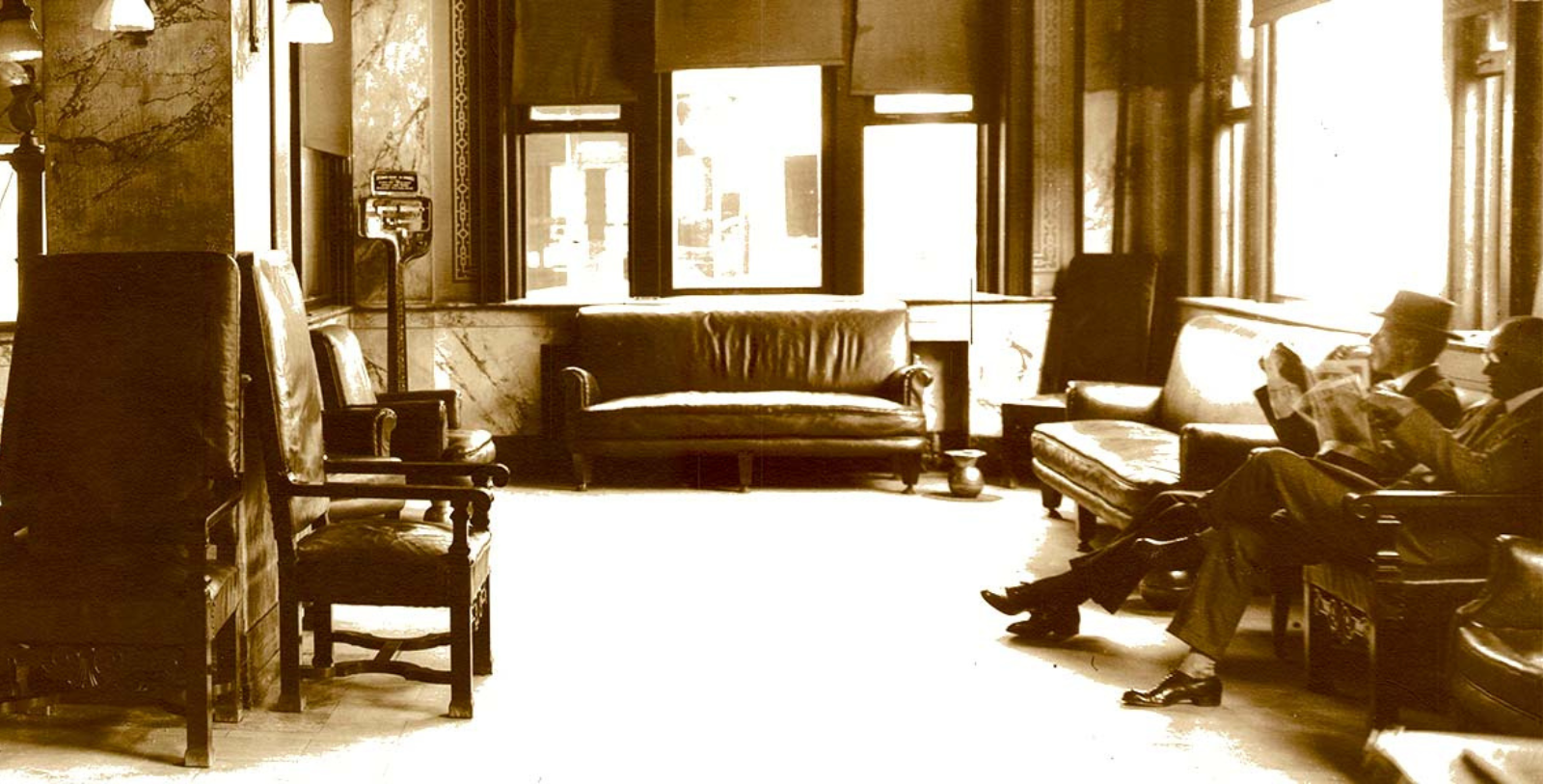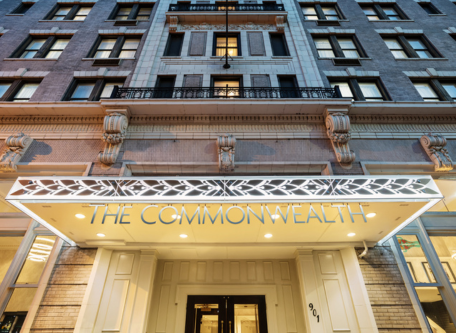Receive for Free - Discover & Explore eNewsletter monthly with advance notice of special offers, packages, and insider savings from 10% - 30% off Best Available Rates at selected hotels.
history of a historic hotel in richmond va
Discover The Commonwealth, which has offered upscale accommodations along Richmond’s noted Main Street Banking District since the early 20th century.
The Commonwealth, a member of Historic Hotels of America since 2023, dates back to 1913.
VIEW TIMELINEDuring the early 1840s, a youthful German immigrant named Louis Rueger settled in the bustling metropolis of Richmond, Virginia. At the time, the city was undergoing a prolonged period of considerable growth, having seen the creation of such industrial juggernauts as the Tredegar Iron Works. Recognizing the tremendous potential all the economic activity presented, Rueger decided to open his own business—a saloon—in the heart of downtown Richmond. The ambitious young man had even procured a lot directly across the street from the Virginia State Capitol complex, ensuring his dining establishment had the best public exposure possible. Rueger excitedly debuted his restaurant for the first time in 1846, which quickly emerged as one of the city’s most visited restaurants practically overnight. Throngs of enthusiastic diners subsequently frequented the eatery every day, ranging from traveling merchants to influential state politicians. This moment marks an early connection to the history of Richmond hotel culture, as Rueger's entrepreneurial presence would later influence the city’s hospitality landscape. This prosperity seemed destined to last forever as well, but the dramatic onset of the American Civil War eventually brought it to an abrupt end. Now functioning as the national capital for the Confederate States of America, Richmond became subject to a declaration of martial law by the Confederate government in early 1862. Regular business throughout the city dwindled considerably in turn, forcing entrepreneurs like Rueger to find other ways to earn a living.
However, the situation in Richmond worsened for Rueger when the Confederate Navy seized his saloon for use as its Commodore’s headquarters. Rueger then opted to escape back to Europe, leaving his cherished restaurant to suffer an uncertain fate. Indeed, he was dismayed to learn that the building had burned down amid a massive fire that Confederate soldiers ignited amid their evacuation of Richmond in 1865. (Confederate President Jefferson Davis had ordered Richmond’s defenders to set the city ablaze rather than surrender it to the Union army.) Nevertheless, Rueger was undeterred and vowed to resurrect the restaurant upon his return to America when the conflict was finally over. After months of construction, the new “Lafayette Saloon” opened to thunderous applause. (The new name was an homage to the Lafayette Artillery Armory, which was located nearby.) Rueger and his family soon reestablished themselves as preeminent restaurateurs, becoming respected fixtures within Richmond’s business community once more. The restaurant grew immensely, too, prompting the Rueger family to expand its size throughout the Gilded Age. The Ruegers eventually connected a quaint 24-room hotel next to the Lafayette Saloon to care for patrons passing through the area. Christened the “Hotel Rueger,” the new building emerged as a beloved local landmark in its own right following its debut at the start of the 20th century.
To preserve the success of both the restaurant and hotel, Louis Rueger’s grandson, William Rueger, commissioned the creation of a whole new facility on the eve of World War I. Wishing to unite the two businesses within one grand structure, William Rueger set about developing an ornate building with the help of architect Charles M. Robinson in 1912. Together, the men crafted a gorgeous multistory hotel that showcased a mesmerizing blend of Classical Revival motifs. When construction concluded a year later, the new “Hotel Rueger” impressed all who saw it. Many ornate guestrooms filled the space, of which nearly 80 percent had their own bathrooms. Meanwhile, the family restaurant had grown to feature a main dining room and eight additional private dining spaces for intimate parties. Rueger and Robinson had even created a sublevel for the restaurant in the basement—a grill room designed exclusively for businesspeople. William Rueger’s vision proved very wise, as the overhaul solidified the hotel’s reputation for generations to come. Known today as “The Commonwealth,” this terrific historic destination continues to enchant countless guests in the present. Its current owner, SMI Hotel Group, has striven to safeguard its tremendous heritage, too, going as far as to rename the on-site restaurant “Rueger’s” in honor of the Rueger family. Few places in Richmond are truly better for a memorable vacation experience than this fantastic historic hotel.
-
About the Location +
Toward the beginning of the 18th century, the site of present-day Richmond was known among the Virginia colonists for its strategic location along the James River. Settlement had remained sparse, though, consisting of only a few dozen Euro-American families. However, the area’s fate changed dramatically after the passage of the Warehouse Act by the Virginia House of Burgess in the early 1730s. The legislation specifically called for the inspection of tobacco cultivation, then Virginia’s most lucrative industry. As such, planter William Byrd II began constructing one of the depots close to his estate, ultimately leasing a sizeable tract of land to create an accompanying town. Work on Byrd’s new community began in earnest in 1737, with civil engineer William Mayo laying out the original street grid. Byrd subsequently called his new town “Richmond” in honor of Richmond, England, as they both enjoyed similar landscapes. Richmond remained small despite its essential role in Virginia’s colonial economy, hovering around a couple hundred residents on the eve of the American Revolution. Nonetheless, the community saw itself at the forefront of the movement once it erupted across the Thirteen Colonies in the 1770s.
Among the most prominent events in the town was Patrick Henry’s famous “Give me liberty, or give me death” speech at St. John’s Church, which historians often cite as one of the American Revolution’s most prominent moments. Virginia politicians sympathetic to the Patriot cause gradually met in Richmond afterward, leading to its designation as the new state capital in 1780. However, its rich affiliation with the revolutionaries made it a target for the British military. Notorious American turncoat Benedict Arnold even led a raid on Richmond, forcing the state government—including then-governor Thomas Jefferson—to temporarily flee further into the Virginian interior. Richmond recovered from the attack, emerging as one of Virginia’s leading municipalities in the wake of the American Revolution. In fact, Richmond started to industrialize in the early 19th century, thanks to the debut of the celebrated James River and Kanawa Canal. Now evolving into a full-fledged city, Richmond attracted many industrialists due to its enhanced transportation and hydropower capabilities. Perhaps the most significant business to appear at the time was the sprawling Tredegar Iron Works, which produced a multitude of metallic goods for decades.
This economic activity only increased when the railroads arrived during the 1850s, namely the Richmond and Petersburg Railroad. However, this prolonged period of prosperity featured a darker side, as it was supplemented by African American slavery. The institution became such a bedrock component of the city’s socioeconomic identity that it eventually drove the populace to support the Southern Confederacy once the American Civil War erupted in 1861. Richmond emerged as the Confederacy’s national capital, with the historic Virginia State Capitol as its main legislative building. The city’s importance within the Confederacy ultimately made its capture a central component of the Union’s war strategy, causing many battles to be fought around its borders in 1862 and 1864. But the worst devastation occurred near the end of the war when retreating Confederate soldiers set the metropolis ablaze to prevent anything of significance from falling under Union control. U.S. President Abraham Lincoln then visited the desolated city just a few days later, iconically entering the vacated Confederate capital alongside a troop of Black cavalry soldiers.
Unlike the American Revolution, it took Richmond several years to fully rebuild. Nevertheless, Richmond did finally reemerge once more as one of the most prosperous communities in the American South at the height of the Gilded Age. This new era of economic success continued well into the 20th century, too, which saw the city expand exponentially via various infrastructural and commercial projects. Richmond still struggled with the legacies left behind by the American Civil War though, specifically the fate of its African American residents who continued to live in racial segregation. As a result, Richmond became a major battleground in the fight for modern civil rights, with protests taking place all over the city. Among the greatest to occur were the actions taken by the Richmond 34, who famously staged the sit-in of a segregated lunch counter inside the Thalhimers department store. Richmond has since grown to be one of the most culturally diverse communities throughout the entire country, serving as home to fascinating museums, art galleries, universities, and even Fortune 500 companies. The city is particularly noted for its wealth of historic sites that relate intimately to the American Revolution, American Civil War, and Civil Rights Movement. Cultural heritage travelers will surely find Richmond’s past worth learning more about.
-
About the Architecture +
The Commonwealth features a beautiful blend of Classical Revival-style architecture motifs. Also known as “Neoclassical,” Classic Revival design aesthetics are among the most common architectural forms in the United States today. This incredible architectural style first became popularized at the World’s Columbian Exposition, which was held in Chicago in 1893. Many exhibits displayed architectural motifs from ancient societies like Rome and Greece. As with the equally popular Colonial Revival style of the same period, Classical Revival architecture found an audience for its more formal nature. It specifically relied on stylistic design elements that incorporated such structural components as the symmetrical placement of doors and windows and a front porch crowned with a classical pediment. Architects would also install a rounded front portico with a balustraded flat roof. Pilasters and other sculptured ornamentations proliferated throughout the façade of the building, too. Perhaps the most striking feature of buildings designed with Classical Revival-style architecture were massive columns that displayed some combination of Corinthian, Doric, or Ionic capitals. With its Greco-Roman temple-like form, Classical Revival-style architecture was considered most appropriate for municipal buildings, including courthouses, libraries, and schools. But the form found its way into more commercial uses over time, such as banks, department stores, and, of course, hotels. The celebrated architectural firm McKim, Meade, and White produced some of the most noteworthy buildings that utilized Classical Revival architecture, with most of their work appearing during the early 20th century. Examples of their portfolio can be found throughout many major cities, including Philadelphia, New York City, and Richmond.































